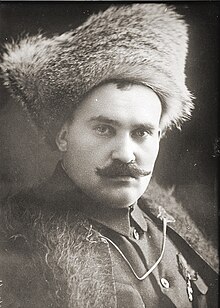Grigory Mikhailovich Semyonov
Grigory Michailowitsch Semjonow ( Russian Григорий Михайлович Семёнов , scientific transliteration Grigorij Michajlovič Semënov ; * 13 September July / 25 September 1890 greg. In Kuransha near Nizhny Zassutschei was a Russian in Moscow August 30, 1946 , † ) General and a leader of the whites in the Russian Civil War .
Life
Semyonov was born in a Cossack settlement in the Transbaikal region . He began his military career in 1911 when he successfully graduated from Orenburg Military School . He took part in the First World War as the tsarist army with the rank of Jesaul . For his work in Poland he was awarded the Georgskreuz of the 4th grade and the sword of honor . After the February Revolution of 1917 , the Provisional Government of Semyonov sent him to the Baikal region as a commissioner in July 1917 to raise revolutionary troops. AfterIn the October Revolution he undertook a failed uprising against the Bolsheviks , which is why he had to briefly withdraw to Manchuria . In August 1918, with the help of the Czechoslovak legions , he succeeded in regaining his former sphere of influence in the Baikal region.
There he established a reign of terror that became known in the country as Semenovchina . He was later appointed commander of a unit stationed in Chita by the self-appointed Provisional Government of Siberia . This initially brought him into a conflict with Admiral Kolchak , the main leader of the White Army in Siberia, who initially refused to recognize Semyonov's command. In the course of the dispute with the Bolsheviks, however, Kolchak had to bow to factual constraints and, under pressure from the Entente states , which had temporarily intervened in the fight with the Bolsheviks , appointed Semyonov commander of the military district of Chita and promoted him to lieutenant general of the whites in 1919 Army . In the spring of the same year Semyonov also named himself ataman of the Cossacks of the Transbaikal region with the support of Japan .
After Kolchak's White Army had been defeated by the Bolsheviks, the latter transferred his powers to Semyonov for the entire Far East of Siberia. In November 1920 Semyonov was then expelled from the Baikal region by partisans and regular units of the Red Army , which Vasily Blücher commanded. He then went further east with his troops and tried to establish himself in the Primorye region with the help of the Japanese secret service . After further fighting with the Red Army, however, he was defeated there and finally had to flee into exile in China in September 1921 .
Semyonov spent his time in exile in Korea , Japan and northern China . There he used his contacts to the Japanese secret service and was the leader of the white emigrant community in the Far East . As such, he was also instrumental in anti-Soviet activities. To improve his financial situation, he was the bodyguard of the former Emperor of China in Tianjin from 1925 to 1931 . When the Soviets intervened in the fight against Japan in 1945 towards the end of the Second World War and occupied Manchuria, Semenov was captured by the Red Army in September 1945. He was sentenced to death in the Soviet Union and hanged on August 30, 1946 .
literature
- Walter Rosenwald : The ataman Semjonow, his bravery cross and his commemorative badge. In: Orders and Medals. Issue 21, 2002, pp. 7-11.
- Jamie Previously: White Terror: Cossack Warlords of the Trans-Siberian ; Routledge, 2005; ISBN 0-7146-5690-9
- Brian Power: The Ford of Heaven: A Childhood in Tianjin, China ; Signal Books, 2005; ISBN 1-904955-01-0
Individual evidence
- ↑ Jamie previously: White Terror , p. 298.
- ^ Brian Power: The Ford of Heaven: A Childhood in Tianjin, China , p. 101.
| personal data | |
|---|---|
| SURNAME | Semjonow, Grigory Mikhailovich |
| ALTERNATIVE NAMES | Семёнов, Григорий Михайлович (Russian spelling) |
| BRIEF DESCRIPTION | Russian general during the Russian Civil War |
| DATE OF BIRTH | September 25, 1890 |
| PLACE OF BIRTH | Kuranscha , Transbaikal Oblast |
| DATE OF DEATH | August 30, 1946 |
| Place of death | Moscow , Soviet Union |
